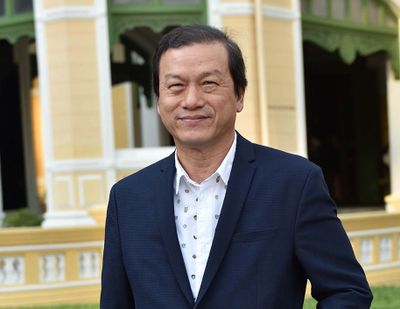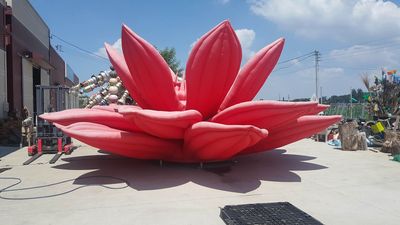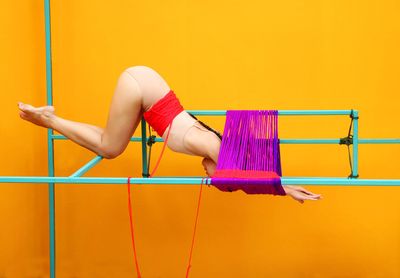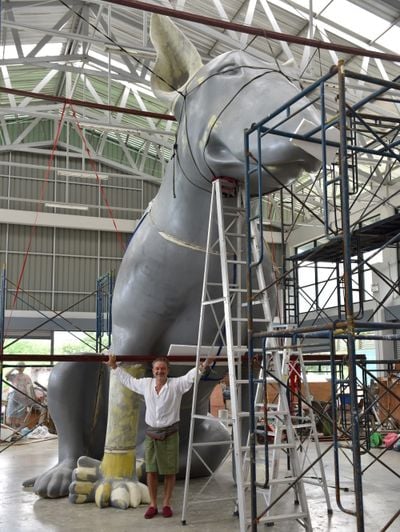Dr Apinan Poshyananda
Dr Apinan Poshyananda. Courtesy Bangkok Art Biennale.

Dr Apinan Poshyananda. Courtesy Bangkok Art Biennale.
The first edition of the Bangkok Art Biennale (BAB), Beyond Bliss, ran from 19 October 2018 to 3 February 2019 at 20 locations across the Thai capital, including heritage landmarks such as the East Asiatic Building, a Venetian-style old-world delight, and two of the city's most visited temples: Wat Pho (Temple of the Reclining Buddha) and Wat Arun (Temple of Dawn).
The ambitious contemporary art event is organised by the Bangkok Art Biennale Foundation, which was set up in 2017 by the country's largest beverage conglomerate, ThaiBev, with key support from other sponsors from both the private and public sectors. Dr Apinan Poshyananda, who is the permanent secretary and acting minister at Thailand's Ministry of Culture, is the Biennale's affable and outspoken artistic director. For the inaugural edition, Dr Poshyananda led a curatorial team of the region's top curators and international advisors, from Thai art scene veterans like artist Rirkrit Tiravanija and previous Bangkok Art and Culture Centre (BACC) Director Luckana Kunavichayanont, to University of the Philippines professor Patrick D. Flores, who curated the Philippines' return to the Venice Biennale in 2015 after a half-century hiatus, and Fumio Nanjo, director of the Mori Art Museum in Tokyo.
As with many urban biennial exhibitions, the Bangkok Art Biennale is as much a celebration of art as it is a bid for cultural soft power; in this case to bolster a hip, creative city on the rise. The backing of both art world and corporate heavyweights distinguishes the BAB from two similar events that were also launched in Thailand in 2018: the government-run Thailand Biennale, whose inaugural edition, curated by Jiang Jiehong, took place in the southern province of Krabi from 2 November 2018 to 28 February 2019; and the guerrilla-style Bangkok Biennial, which was staged at pop-up pavilions throughout the city in the summer of 2018 by an anonymous cabal of Thai art world disruptors, who sought to subvert what they outlined in a statement as 'top-down art economics'.
The BAB's artist line-up was decided following a worldwide open call, and featured establishment names such as Marina Abramović, Huang Yong Ping, and Yayoi Kusama, alongside young and emerging Thai artists, who represented 34 out of the 75-strong list. Among the highlights were contemporary dance artist Pichet Klunchun, video artist Kawita Vatanajyankur, and performance artist Jittima Ponsawek. As Dr Poshyananda notes, the Biennale will offer artists a strong platform to exhibit their work: 'They will be on the international stage, but at home.'
SLTell us about your decision to launch the Bangkok Art Biennale this year. Why here and why now?
APAs you know, biennials have been mushrooming across Asia for more than 20 years. In Thailand, and in this case Bangkok, there has always been a longing and demand to have a contemporary art event. The artists here are very promising and many are shown internationally. On top of that, Bangkok is a popular place for visitors. Strategically, it's at the centre of the ASEAN economies. It's a good place for an art biennial, but it has never happened until now.
To stage a biennial of any kind, you need peace. If you're going to have a coup every two years, you cannot have a biennial. If you have disruption and civil unrest, art is very sensitive to these things. Singapore has been staging biennials for ten years. Singapore will never have a coup; it is safe with a steady continuation of government policy. So, now that Thailand has relative peace and stability, the time is right and ripe to put on such an event.
On top of that, we felt that if we were going to launch anything, we must have sustainability, we must have longevity, and we must have confidence. We would like the Biennale to be a continued event, and not just a one-off. We felt it was important to have support from the private sector. The government is very good at providing in-kind support, but not reliable on budget.
SLGiven the boom of biennials in the region, what will BAB offer that's unique?
APThe backdrop is different, which means the nuances, the ambience, and the DNA are unique. In 2017, when we announced the beginning of the Bangkok Art Biennale, we chose to do it in Venice; to position Bangkok as a Venice of the East with an event that would give the Chao Phraya a feeling of the Grand Canal. The exhibition uses heritage landmarks like the East Asiatic Building, marking the first time that the building is being used for contemporary art.
We also used three important temples, which attract thousands of visitors a day—Wat Pho, or the Temple of the Reclining Buddha; Wat Arun, which is the Temple of Dawn; and Wat Prayoon.
We knew the audience might include people who travel every three months to a biennial. When they see a regurgitation of the same method of display, same catalogue, same food, same drinks ... of course they're going to get bored! That's why we had to make it different, and different means difficult. I spoke with a lot of abbots, let me assure you.
SLWhat are some of the special commissions that were included in these historical contexts?
APFrench artist Aurèle Ricard created a five-metre-high sculpture, which was placed outside the Mandarin Oriental Hotel. The finished gold version was called LostDog. This piece explored the idea that the human race is lost because belief in faith is lost. Through the artwork, we asked: are Thai people lost? We have been through five years of disillusionment and frustration since the end of the coup d'état.
Another commission was by Elmgreen & Dragset, which was staged at the East Asiatic Building, where Siamese and Danish trading began. Since Elmgreen is from Denmark, we received some support from the Danish government. The new work was called Zero. It was their second high-profile pool sculpture after Van Gogh's Ear was exhibited at the Rockefeller Center in 2016.
SLCould you tell us more about the exhibition title, Beyond Bliss, and the curatorial theme?
APThe theme itself was intentionally paradoxical. It was drawn not only from Buddhist philosophy but also from the question of life: how do you find happiness and how do you go beyond it? We get up every morning and what we hear on the news is chaos. In this day and age of trauma and turmoil, how can we prolong that short period of happiness in our lives? We don't live very long, but can we get along each day without having to go through sorrow? How do we do that?
The 75 artists have interpreted this question and will lead us, like pilgrims, through the 20 venues in Bangkok. We may not like the path that one artist has given us, but then we can explore another. The artists lead us, not the curators. If we're lucky, the viewers will find that short moment of happiness through art. You have to see the artwork, and then you see yourself. It's like a journey, or a jigsaw. In this way I think it will be enriching, enlightening and enjoyable.
SLDid you run into any problems with censorship while planning the Biennale?
API worked in the Ministry of Culture for many years, so I know how to get away with it. A lot of people misunderstand what can be shown and what cannot be shown, and what self-censorship is. If you are not sure, then the easiest way out is not to show the work at all. On the other hand, some people court sensationalism—they may not feel something in their heart but they do it in their work. When political art is made to be sold, that's a big problem.
Chumpon Apisuk made a work for us about Thai and migrant sex workers, documenting more than a dozen women in Chiang Mai and giving them a chance to speak out. These women work day after day; they're abused, but they use it in such a way that is their own resistance, whether that means buying a new mobile phone or sending money back to their families. Chumpon wanted to understand what bliss is through their eyes.
We thought it would be dangerous in terms of embarrassment or infringement, but the subjects were willing to be filmed. In terms of sensitivity, I think this work was very daring.
SLWhat is your impression of the current state of Thai contemporary art?
APIt's in a growing-up period. We are filling in the gaps that we are not used to. We will hopefully see an improvement of infrastructure and a maturity of the younger galleries that will lead to more sales and eventually to commercial events like art fairs, which Thailand has never had.
SLIt's an exciting time for culture in the region.
APYes, because it is so unexciting in Europe. It's so boring, lacklustre, and poor. I went to the 2018 Berlin Biennale and it was so dry. I think it's a reflection of the zeitgeist in Europe: uncertainty, violence, terrorism, Brexit, the economy, fear.
Asia was also in that period of fear—fear of superpowers, fear of communism. But the little countries are more mature now, and for the so-called advanced countries of the EU, there is a question: does it even work? Is it going down the drain?
SLDoes Thailand have a bigger role to play in the development of Southeast Asian art generally?
APWe must be humble. We cannot say we are going to have one Bangkok Art Biennale and we are going to be a success. We must learn from our friends who have done it before in Singapore, Jakarta, and elsewhere. There will be many mistakes and many obstacles, but we will grow at our own pace. If we're not humble and if we're not careful, it won't last. —[O]















































































































































































